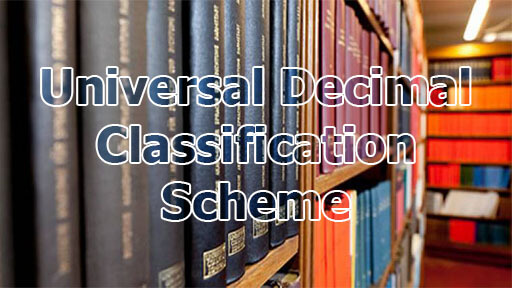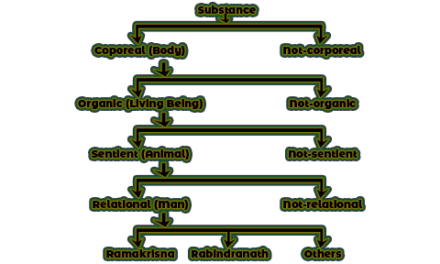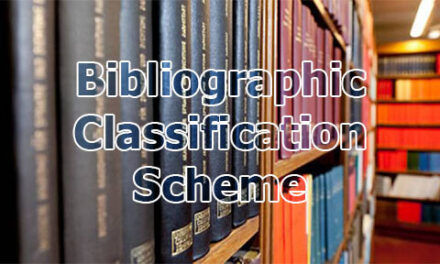Universal Decimal Classification Scheme:
The Universal Decimal Classification (UDC) is a bibliographic and Library Classification representing the systematic arrangement of all branches of human knowledge organized as a coherent system in which knowledge fields are related and inter-linked.
The UDC is an analytico-synthetic and faceted classification system featuring detailed vocabulary and syntax that enables powerful content indexing and information retrieval in large collections. Since 1991, the UDC consortium, a non-profit international association of publishers.
Basic Structure of UDC:
UDC allows on unlimited combination of attributes of a subject and relationships between subjects to be expressed. Some of the basic Structure of UDC are briefly given below:
1. Principles of Organization: The organization of UDC is discipline-based. This means all concepts are subsumed and placed in the field under which they are studied. This particular feature is usually implemented in UDC by re-using the same concept in various combinations with the main subject. For examples; (410) United Kingdom, Uniquely representing the concept of United Kingdom can be used to express, 911(410) Regional Geography of United Kingdom, or 94(410) History of United Kingdom.
2. UDC Hierarchic Structure: UDC’s most innovative and influential feature is its ability to express not just simple subjects but relations between subjects. This facility is added to a hierarchic structure, in which knowledge is divided into ten classes, then each class is subdivided into its logical parts, each subdivision is further subdivided and so on. The more detailed the subdivision the longer the number that represents it. This is made possible by the decimal notation. For examples;
| Notation | Description |
| 5 | Mathematics, Natural Sciences |
| 53 | Physics |
| 539 | Physical Nature of Matter |
| 539.1 | Nuclear Physics, Atomic Physics, and so on |
3. UDC Tables: The whole universe of knowledge in UDC is divided into two categories:
a. Systematic Table: The systematic tables are also called schedules which give the notational number of all basic classes from 0-9. The general order of the main table is the same as DDC. The whole universe of knowledge is divided into ten main branches denoted by decimal fractions, Indo-Arabic Numerals. UDC uses one digit number for the main class. The main class numbers and their subdivision are divided by a continuous extension of the decimal fraction on the principle of proceeding from general to specific. The practice of DDC to use a dot after every three digits has been retained in UDC. In UDC, the 4th class is kept vacant for future subjects.
0 – Generalities of Knowledge
1 – Philosophy, Metaphysics, Logic, Ethics, Phycology
2 – Region, Theology
3 – Social Sciences, Statistics, Law
4 – Vacant
5 – Mathematics and Natural Sciences
6 – Applied Sciences, Medicine and Technology
7 – The arts, Recreation, Entertainment
8 – Language, Linguistics, Literature
9 – Geography, Bibliography, History
Later on these main classes are divided into sub-divisions and sections. e.g.
6 – Applied Sciences
61 – Medical Sciences
62 – Engineering Sciences and so on
These subdivisions are divided into section like;
611 – Anatomy
612 – Physiology
613 – Personal Health
614 – Public Health
b. Auxiliary Table: The auxiliaries are a set of facets and facet indicators, which enable the classifier to synthesize freely. Auxiliaries are further divided into; common and special auxiliaries.
4. Notation of UDC: The UDC is based on the outline and the notational base of the DDC. The basic notation of UDC consists of Indo-Arabic Numerals 0-9 used decimal, the different mathematical symbols and punctuation marks make its notation into mixed notation. The use of different signs and symbols has added qualities of notation of UDC. Symbols used in UDC are:
| Symbols | Expressed as | Significance |
| + | Plus | Connection of non-connective numbers |
| / | Stoke | Connection of consecutive numbers |
| : | Colon | Relation |
| [ ] | Square Brackets | Relation (subordinate) |
| = | Equals | Language |
| (0) | Brackets Naught | Form |
| (0-9) | Brackets | Place |
| (=) | Brackets Equals | Race and Nationality |
| “ ” | Inverted Commas | Time |
| A-Z | A to Z | Individual Subdivisions |
| – | Hyphen | Special Analytical Numbers |
| .00 | Point Double Zero | Point of View |
| .0 | Point Naught | Special Analytical Numbers |
| * | Asterisk | Introduced non-UDC notation |
5. Index of UDC: Like others classification scheme, UDC also has an index which relative index in nature. Here related subjects are arranged alphabetically under a lead-term.
Common Auxiliaries of UDC:
The common auxiliaries, as well as providing a means of expressing interrelations between subjects, denote generally recurrent characteristics. (i.e. those that are applicable throughout the main tables). These comprise two kinds of symbol: the signs and subdivisions. The signs serve as relations, linking UDC numbers. The subdivisions consist of numeric table which arranged hierarchically. Common Auxiliaries are as follows:
(i) + (Plus) Additional Sign: If there is two or more main classes in publication subject matter and they have no sequence between them they have to add + (Plus) sign. Such as;
Mining and Metallurgy:
| Class No. : | Mining | = 622 |
| Class No. : | Metallurgy | = 629 |
| 622+629 (Desired Number) | ||
(ii) / (Stroke) Extension Sign: If there is any sequence among more main classes, have to write first small number and then use / (Stroke) sing and write the larger number deducting others numbers. Such as;
Physics, Chemistry, and Zoology:
| Class No. : | Physics | = 53 |
| Class No. : | Chemistry | = 54 |
| Class No. : | Zoology | =55 |
| 53/55 (Desired Number) | ||
(iii) : (Colon) Relation Sign: : (Colon) Sign is to be used for understanding more same status related subjects. Such as;
Statistics Applied to Agriculture:
| Class No. : | Statistics | = 31 |
| Class No. : | Agriculture | = 63 |
| 31:63 (Desired Number) | ||
(iv) [ ] (Square Bracket) Subordinate Sign: [ ] sign is to be used for understanding the subordinate relationship among more subjects’ matters. Such as;
Science Education:
| Class No. : | Science | = 5 |
| Class No. : | Education | = 37 |
| 5[37] (Desired Number) | ||
(v) = (Equal) Language Sing: = sign is to be used for expressing of publication language in classification. Such as;
Mining in English:
| Class No. : | Mining | = 622 |
| Class No. : | English | = 20 |
| 622=20 (Desired Number) | ||
(vi) (0/09) Form Sign: (0/09) is to be used for including any special form with main class. Such as;
Periodicals on Law:
| Class No. (MC) : | Law | = 34 |
| Form : | Periodicals | = (051) |
| 34(051) (Desired Number) | ||
(vii) (1/9) Place Sign: If there is any special geographical are included with subject matter then has to add (1/9) sign after main class. Such as;
The German Railway System:
| Class No. (MC) : | Railway System | = 385 |
| Place : | Germany | = (43) |
| 385(43) (Desired Number) | ||
(viii) (=…) Race and Nationality: (=…) sign is to be used for including the characteristics of any special race and nationality after main class. Such as;
Folklore of Bengalis:
| Class No. (MC) : | Folklore | = 398 |
| Race and Nationality : | Bengalis | = (=914.4) |
| 398(=914.4) (Desired Number) | ||
(ix) “….” Time Sign: “….” sign is to be used for expressing of publication period of subject matter at classification number after main class. Such as;
Economic Development of Bangladesh in 1988:
| Class No. (MC) : | Economic Development | = 330.19 |
| Place : | Bangladesh | = (549.2) |
| Time : | 1988 | = “1988” |
| 330.19(549.2) “1988” (Desired Number) | ||
(x) (A/Z) Alphabetical Subdivision: If there is any information about any person in publication then has to include some initial letters of his/her name in first brackets after main class. Such as;
Biography of Shakespeare:
| Class No. (MC) : | Biography | = 92 |
| Alphabetical Subdivision : | Shakespeare | = (Shak.) |
| 92(Shak.) (Desired Number) | ||
(xi) Numerical Subdivision: Special edition number of publication is mentioned in UDC Scheme. Such as;
Dewey decimal classification 23rd edition:
| Class No. (MC) : | Dewey Decimal Classification | = 025.45 DC |
| Numerical Subdivision : | 23rd edition | = 23 |
| 025.45 DC 23 (Desired Number) | ||
(xii) .00 Point of View Sign: .00 sign is to be used for understanding any special attitude of included subject matter of publication. Such as;
Organization and Management of Mining:
| Class No. (MC) : | Mining | = 622 |
| Point of View : | Organization and Mangement | = .008 |
| 622.008 (Desired Number) | ||
Special Auxiliaries of UDC:
The special auxiliaries occur at various places in the UDC tables. They express concepts that are recurrent, but in a more limited subject range. The following auxiliaries are used in special fields:
(i) – Hyphen: – is an analytical Special division. Such as;
Machinery = 621
Shape and form of materials, products, etc. = 621–4
(ii) .0 Point Naught: .0 is also an analytical special division. Such as;
Building = 69
Wall of Building = 69.022
(iii) ’ Apostrophe: ’ sign is used to identify the element of subject. Such as;
Sodium = 546.33
Sodium Chloride = 546.33’13
Features of UDC:
UDC has following features:
- Faceted classification: UDC uses a faceted approach to classification, meaning that subjects are classified based on multiple facets or aspects (such as topical, geographic, and temporal).
- Hierarchical structure: UDC has a hierarchical structure, with more specific subcategories nested under broader categories.
- Numerical notation: UDC uses a numerical notation to represent each category, with the main classes represented by whole numbers and the subdivisions represented by decimal numbers.
- Standardized system: UDC is a standardized system of classification, which means that it is used by libraries and other information centers all over the world.
- Multilingual: UDC is available in multiple languages, making it a truly global classification system.
- Expandable: UDC is an expandable classification system, which means that new categories can be added as new subjects emerge.
- Common auxiliary tables: UDC has a number of common auxiliary tables that are used to supplement the main classification schedule and help classify specific subject areas.
- Common subdivisions: UDC uses common subdivisions to further narrow down the subject being classified.
- Extensive coverage: UDC covers a wide range of subject areas, making it useful for libraries and information centers that deal with diverse collections.
- Flexible: UDC is a flexible classification system that can be adapted to meet the needs of different types of collections and users.
So, in UDC is no basic change of DDC, only has extended the symbols according to characteristics and necessity of subject. In this scheme Arabic number has used as basic symbol main class. Besides, some auxiliaries have used for language of publication depth of subject, presentation of attitude etc. One symbolic sign is used for each auxiliary.

Library Lecturer at Nurul Amin Degree College











